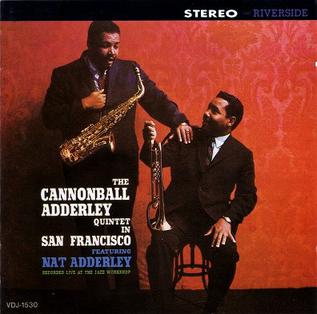This Here – Bobby Timmons
One of Bobby Timmons' most iconic compositions, This Here did as much as any song to establish the soul-jazz sound. We have lead sheets and rhythm section parts from both the Cannonball Adderley quintet and Bobby Timmons trio versions, as well as an easy sextet arrangement based on the latter recording.
- Recording: Cannonball Adderley - The Cannonball Adderley Quintet In San Francisco
- Recorded on: October 20, 1959
- Label: Riverside (RLP 12-311)
- Concert Key: F
- Vocal Range: , to
- Style: Gospel (medium up)
- Cornet - Nat Adderley
- Alto Sax - Cannonball Adderley
- Piano - Bobby Timmons
- Bass - Sam Jones
- Drums - Louis Hayes
Video
- Description
- Historical Notes
- Solos
- Piano Corner
- Bass Corner
- Drum Corner
- Guitar Corner
- Inside & Beyond
- Minus You
The solo form is an even 32 measures with no break; the piano and bass play the ostinato from the head on the first chorus of each solo. In this version they also play it at the end of the last chorus of each solo to set up the next soloist. The last chorus of the last solo is extended to 36 measures like the head, which we show as a D.S. to the last four measures of the intro.
This arrangement's intro is not quite a chorus long. The rhythm section plays eight measures of F7, four measures of B♭7, and 12 more measures of F7 with the horns' pickup to the head. Our melody lead sheets show a rhythm section cue for the last eight measures of the intro only; the rhythm section parts have the full intro. The end fades out on the same vamp as the intro; on the recording, the rhythm section goes to B♭7 as they fade like the intro, but this is not shown in our lead sheets and parts.
The two horns play mostly unison and harmonize only at the start of the B section, so instead of 1st and 2nd horn parts for this arrangement we have lead sheets which include the harmonies in these measures. A chorus of backgrounds for the piano solo is also included, with two-part harmonies in all lead sheets. Piano, bass, and drum parts are available as well as the full quintet score. Our audio excerpt starts with the last eight measures of the intro, including the piano pickup.
Related Songs
Email Send This Here to a friend
- Recording: Bobby Timmons - This Here Is Bobby Timmons
- Recorded on: January 13 or 14, 1960
- Label: Riverside (RLP 12-317)
- Concert Key: F
- Vocal Range: , C4 to C4
- Style: Gospel (medium up)
- Piano - Bobby Timmons
- Bass - Sam Jones
- Drums - Jimmy Cobb
Video
- Description
- Historical Notes
- Solos
- Piano Corner
- Bass Corner
- Drum Corner
- Guitar Corner
- Inside & Beyond
- Minus You
The intro is only eight measures. Bobby plays two solo choruses on the recording: one with the bass ostinato from the head and a second chorus with the bass walking. This second chorus is extended to 36 measures; Bobby plays the intro figure on the last eight, so our lead sheets and parts show a D.C. to the intro four measures before the end of the solo chorus.
Piano and bass parts are available; click on Piano Corner for more about the former. Drummers can use the lead sheet or the piano part.
An Easy Sextet arrangement by jazzleadsheets.com's Don Sickler is also available. This arrangement is based on Bobby's trio version, and is mostly a piano melody feature with the horns playing the ostinato figures. The trumpet 1st part takes over the melody at C. There is a two-chorus background that could work for a horn soloist as well as a piano solo; it's based on Bobby's solo and comping on this recording.
Related Songs
Email Send This Here to a friend

Bobby Timmons
December 19, 1935 – March 1, 1974
A beloved pianist with one of the most easily recognizable styles, Bobby Timmons is responsible not only for bringing his unique gospel-tinged voice to the piano, but also for his funky compositional masterpieces that have become jazz standards, like Moanin’ and This Here (Dis Here). These two are by no means the only memorable original works of Bobby’s—nearly all of his works are instantly recognizable as Bobby Timmons originals, as they all have his signature style of soul, funk, and gospel, while maintaining the hallmarks of true hard-bop jazz. Born in Philadelphia to a religious family, Bobby studied piano with his uncle, who also taught McCoy Tyner. He moved to New York at age 20 to start his recording career with Kenny Dorham’s Jazz Prophets. Read more...


